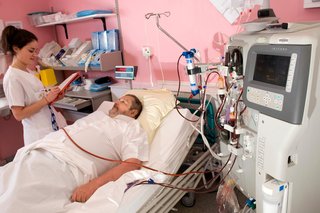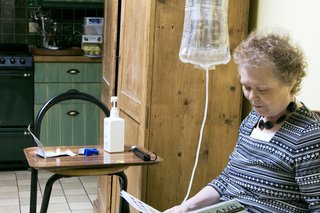Dialysis is a procedure to remove waste products and excess fluid from the blood when the kidneys stop working properly. It often involves diverting blood to a machine to be cleaned.
Normally, the kidneys filter the blood, removing harmful waste products and excess fluid and turning these into urine to be passed out of the body.
Why do I need dialysis?
If your kidneys are not working properly – for example, because you have advanced chronic kidney disease (kidney failure) – the kidneys may not be able to clean the blood properly.
Waste products and fluid can build up to dangerous levels in your body.
Left untreated, this can cause a number of unpleasant symptoms and eventually be fatal.
Dialysis filters out unwanted substances and fluids from the blood before this happens.
How long will I need dialysis for?
It depends. In some cases, kidney failure may be a temporary problem and dialysis can be stopped when your kidneys recover.
But often, someone with kidney failure will need a kidney transplant.
It's not always possible to carry out a kidney transplant straight away, so dialysis may be needed until a suitable donor kidney becomes available.
If a kidney transplant is not suitable for you – for example, because you're not well enough to have a major operation – dialysis may be needed for the rest of your life.
What happens during dialysis
There are 2 main types of dialysis: haemodialysis and peritoneal dialysis.
Haemodialysis
Haemodialysis is the most common type of dialysis and the one most people are aware of.
During the procedure, a tube is attached to a needle in your arm.
Blood passes along the tube and into an external machine that filters it, before it's passed back into the arm along another tube.
At dialysis centres, this is usually carried out 3 days a week, with each session lasting around 4 hours.
It can also be done at home. Some examples of a home dialysis schedule include:
- 4 times a week for 4 hours
- 5 times a week for 3 hours
- 6 days a week for 8 hours overnight
Peritoneal dialysis
Peritoneal dialysis uses the inside lining of your abdomen (the peritoneum) as the filter, rather than a machine.
Like the kidneys, the peritoneum contains thousands of tiny blood vessels, making it a useful filtering device.
Before treatment starts, a cut (incision) is made near your belly button and a thin tube called a catheter is inserted through the incision and into the space inside your abdomen (the peritoneal cavity). This is left in place permanently.
Fluid is pumped into the peritoneal cavity through the catheter. As blood passes through the blood vessels lining the peritoneal cavity, waste products and excess fluid are drawn out of the blood and into the dialysis fluid.
The used fluid is drained into a bag a few hours later and replaced with fresh fluid.
Changing the fluid usually takes about 30 to 40 minutes and normally needs to be repeated around 4 times a day.
If you prefer, this can be done by a machine overnight while you sleep.
Which type of dialysis is best?
In many cases, you'll be able to choose which type of dialysis you want to have and where to have it.
The 2 techniques are equally effective for most people, but each has its own advantages and drawbacks.
For example:
- haemodialysis means you'll have 4 treatment-free days a week, but the treatment sessions last longer and you may need to visit hospital each time
- home haemodialysis – you'll usually be recommended to have dialysis sessions more often than you would in a clinic, but you can choose a treatment plan that meets your medical needs and fits around your life
- peritoneal dialysis can be done quite easily at home and can sometimes be done while you sleep, but it needs to be done every day
If you're able to choose the type of dialysis you prefer, your care team will discuss the pros and cons of each option with you to help you make a decision.
Read more about the advantages and disadvantages of both types of dialysis
Side effects of dialysis
Haemodialysis can cause itchy skin and muscle cramps. Peritoneal dialysis can put you at risk of developing peritonitis, an infection of the thin membrane that surrounds your abdomen.
Both types of dialysis can make you feel exhausted.
Read more about the possible side effects of dialysis.
Life on dialysis
Many people on dialysis have a good quality of life.
If you're otherwise well, you should be able to:
- continue working or studying
- drive
- exercise
- go swimming
- go on holiday
Most people can remain on dialysis for many years, although the treatment can only partially compensate for the loss of kidney function.
Having kidneys that do not work properly can place a significant strain on the body.
This means that people can die while on dialysis if they do not have a kidney transplant, particularly elderly people and those with other health problems.
Someone who starts dialysis in their late 20s can expect to live for up to 20 years or longer, but adults over 75 may only survive for 2 to 3 years.
But survival rates of people on dialysis have improved over the past decade and are expected to continue improving in the future.
Page last reviewed: 14 June 2018
Next review due: 14 June 2021



